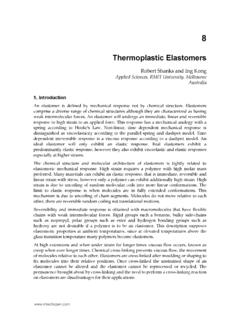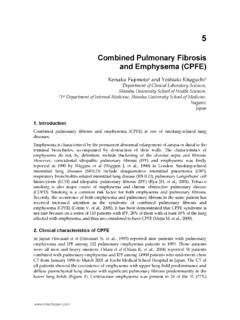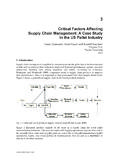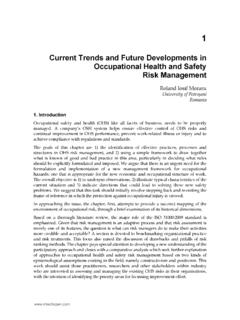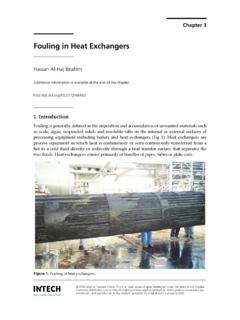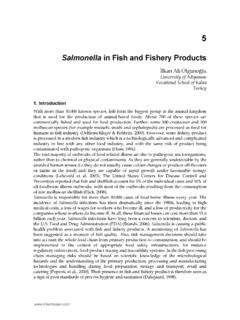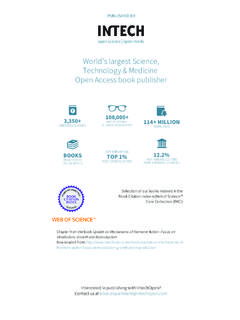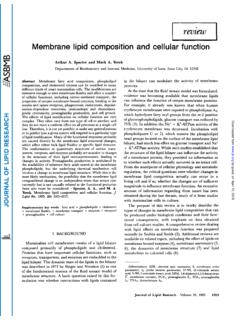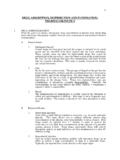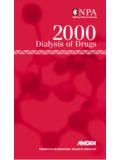Transcription of Lipid Peroxidation: Chemical Mechanism, Biological ...
1 Chapter 1. Lipid Peroxidation: Chemical Mechanism, Biological implications and analytical determination Marisa Repetto, Jimena Semprine and Alberto Boveris Additional information is available at the end of the chapter 1. Introduction Currently, Lipid peroxidation is considered as the main molecular mechanisms involved in the oxidative damage to cell structures and in the toxicity process that lead to cell death. First, Lipid peroxidation was studied for food scientists as a mechanism for the damage to alimentary oils and fats, nevertheless other researchers considered that Lipid peroxidation was the consequence of toxic metabolites ( CCl4) that produced highly reactive species, disruption of the intracellular membranes and cellular damage (Dianzani & Barrera, 2008).
2 Lipid peroxidation is a complex process known to occur in both plants and animals. It involves the formation and propagation of Lipid radicals, the uptake of oxygen, a rearrangement of the double bonds in unsaturated lipids and the eventual destruction of membrane lipids , with the production of a variety of breakdown products, including alcohols, ketones, alkanes, aldehydes and ethers (Dianzani & Barrera, 2008). In pathological situations the reactive oxygen and nitrogen species are generated at higher than normal rates, and as a consequence, Lipid peroxidation occurs with -tocopherol deficiency. In addition to containing high concentrations of polyunsaturated fatty acids and transition metals, Biological membranes of cells and organelles are constantly being subjected to various types of damage (Chance et al.)
3 , 1979; Halliwell & Gutteridge, 1984). The mechanism of Biological damage and the toxicity of these reactive species on Biological systems are currently explained by the sequential stages of reversible oxidative stress and irreversible oxidative damage. Oxidative stress is understood as an imbalance situation with increased oxidants or decreased antioxidants (Sies, 1991a; Boveris et al., 2008). The concept implies the recognition of the physiological production of oxidants (oxidizing free-radicals and related species) and the existence of operative antioxidant defenses. The imbalance 2012 Repetto et al., licensee InTech. This is an open access chapter distributed under the terms of the Creative Commons Attribution License ( ), which permits unrestricted use, distribution, and reproduction in any medium, provided the original work is properly cited.
4 4 Lipid Peroxidation concept recognizes the physiological effectiveness of the antioxidant defenses in maintaining both oxidative stress and cellular damage at a minimum level in physiological conditions (Boveris et al., 2008). Lipid peroxidation is a chain reaction initiated by the hydrogen abstraction or addition of an oxygen radical, resulting in the oxidative damage of polyunsaturated fatty acids (PUFA). Since polyunsaturated fatty acids are more sensitive than saturated ones, it is obvious that the activated methylene (RH) bridge represents a critical target site. The presence of a double bond adjacent to a methylene group makes the methylene C-H bond weaker and therefore the hydrogen in more susceptible to abstraction.
5 This leaves an unpaired electron on the carbon, forming a carbon-centered radical, which is stabilized by a molecular rearrangement of the double bonds to form a conjugated diene which then combines with oxygen to form a peroxyl radical. The peroxyl radical is itself capable of abstracting a hydrogen atom from another polyunsaturated fatty acid and so of starting a chain reaction (Halliwell & Gutteridge, 1984) (Fig. 1). Figure 1. Initiation step of Lipid peroxidation process. Molecular oxygen rapidly adds to the carbon-centered radicals (R.) formed in this process, yielding Lipid peroxyl radicals (ROO.). Decomposition of Lipid peroxides is catalyzed by transition metal complexes yielding alcoxyl (RO.)
6 Or hydroxyl (HO.) radicals. These participate in chain reaction initiation that in turn abstract hydrogen and perpetuate the chain reaction of Lipid peroxidation. The formation of peroxyl radicals leads to the production of organic hydroperoxides, which, in turn, can subtract hydrogen from another PUFA. This reaction is termed propagation, implying that one initiating hit can result in the conversion of numerous PUFA to Lipid hydroperoxides. In sequence of their appearance, alkyl, peroxyl and alkoxyl radicals are involved. The resulting fatty acid radical is stabilized by rearrangement into a conjugated diene that retains the more stable products including hydroperoxides, alcohols, aldehydes and alkanes.
7 Lipid hydroperoxide (ROOH) is the first, comparatively stable, product of the Lipid peroxidation reaction (Halliwell & Gutteridge, 1984) (Fig. 2). Figure 2. Initial phase of the propagation step of Lipid peroxidation process indicating the oxygen uptake. Lipid Peroxidation: Chemical Mechanism, Biological implications and analytical determination 5. Reduced iron complexes (Fe2+) react with Lipid peroxides (ROOH) to give alkoxy radicals, whereas oxidized iron complexes (Fe3+) react more slowly to produce peroxyl radicals. Both radicals can take part in the propagation of the chain reaction. The end products of these complex metal ion-catalyzed breakdowns of Lipid hydroperoxides include the cytotoxic aldehydes and hydrocarbon gases such as ethane.
8 The free radical chain reaction propagates until two free radicals conjugate each other to terminate the chain. The reaction can also terminate in the presence of a chain-breaking anti- oxidant such as vitamin E ( -tocopherol) (Halliwell & Gutteridge, 1984). In conditions in which Lipid peroxidation is continuously initiated it gives non-radical products destroying two radicals at a time. In the presence of transition metal ions, ROOH. can give rise to the generation of radicals capable of re-initiating Lipid peroxidation by redox-cycling of these metal ions (Halliwell & Gutteridge, 1984). Lipid peroxidation causes a decrease in membrane fluidity and in the barrier functions of the membranes.
9 The many products of Lipid peroxidation such as hydroperoxides or their aldehyde derivatives inhibit protein synthesis, blood macrophage actions and alter chemotactic signals and enzyme activity (Fridovich & Porter, 1981). 2. Biological implications of Lipid peroxidation The Biological production of reactive oxygen species primarily superoxide anion ( ) and hydrogen peroxide (H2O2) is capable of damaging molecules of biochemical classes including nucleic acids and aminoacids. Exposure of reactive oxygen to proteins produces denaturation, loss of function, cross-linking, aggregation and fragmentation of connective tissues as collagen (Chance et al., 1979). However, the most damaging effect is the induction of Lipid peroxidation.
10 The cell membrane which is composed of poly-unsaturated fatty acids is a primary target for reactive oxygen attack leading to cell membrane damage. The Lipid peroxidation of polyunsaturated fatty acids may be enzymatic and non-enzymatic. Enzymatic Lipid peroxidation is catalyzed by the lipoxygenases family, a family of Lipid peroxidation enzymes that oxygenates free and esterified PUFA generating as a consequence, peroxy radicals. Non enzymatic Lipid peroxidation and formation of Lipid - peroxides are initiated by the presence of molecular oxygen and is facilitated by Fe2+ ions (Repetto et al., 2010a). Oxidative breakdown of Biological phospholipids occurs in most cellular membranes including mitochondria, microsomes, peroxisomes and plasma membrane.


